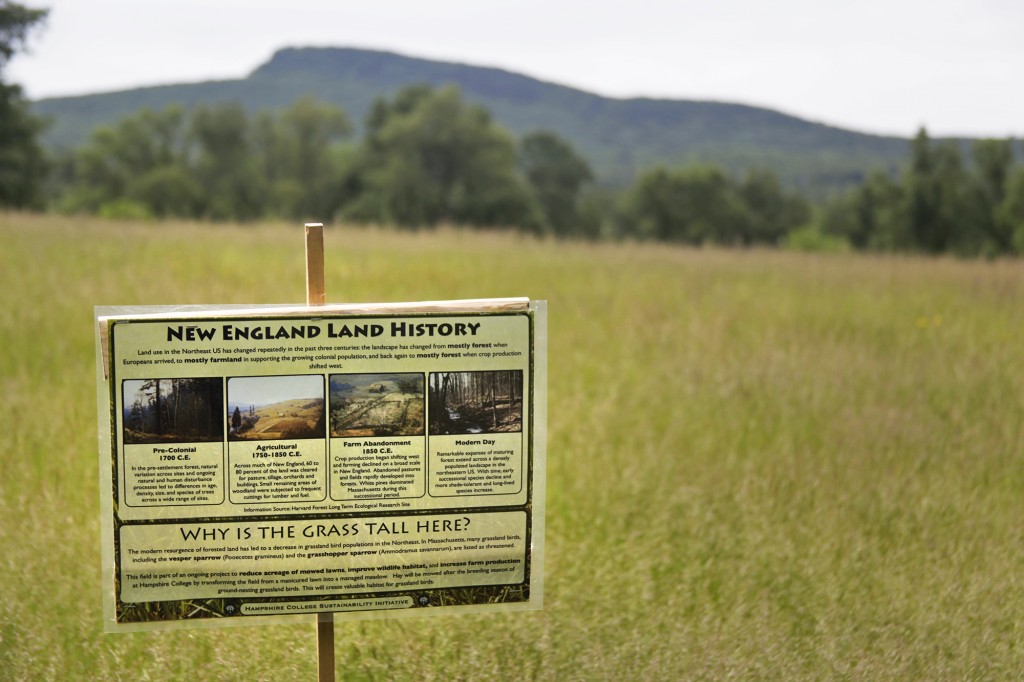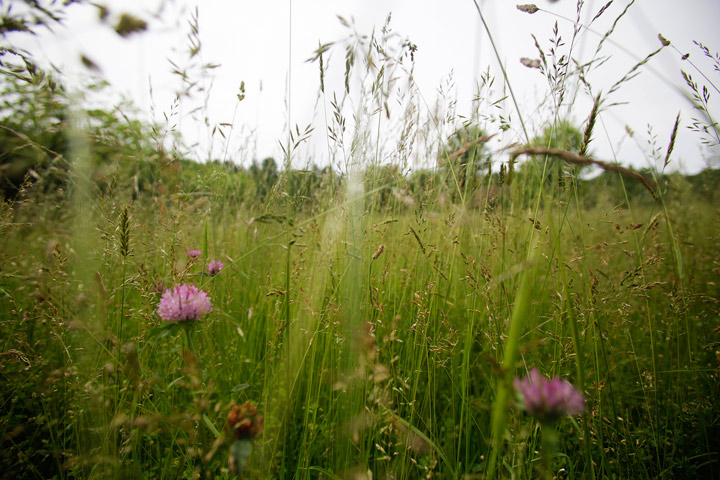 If picturing a New England college campus in their minds, many people would see wide expanses of close-cropped lawn. Here at Hampshire College, sustainability-minded students had a different image:
If picturing a New England college campus in their minds, many people would see wide expanses of close-cropped lawn. Here at Hampshire College, sustainability-minded students had a different image:
They — and the faculty, staff, and administrators working with them — envisioned a campus of attractive, ecologically-diverse meadows that could reduce greenhouse gas emissions, create wildlife and plant habitats, and produce savings on grounds-care costs while also providing teaching, learning, and research opportunities.
That vision is becoming reality. With a new growing season in full bloom, Hampshire has ceased mowing about nine acres and is converting them into managed meadowlands. Areas near the College’s main entrance are included.
The meadowlands project includes long-term plans to leave as manicured lawn only those spaces inside of the road that rings the heart of campus and includes major academic and residential buildings, plus the continued mowing of paths and activity spaces elsewhere on campus.
Projections suggest this choice will reduce CO2 releases by up to 12,000 pounds annually. Staff time previously used for mowing, around 16 hours a week for 28 weeks each year, will be freed for other important tasks on campus. And the College will save approximately $2,300 annually in diesel fuel costs.
Students became interested in transforming lawns into meadows after being invited to assist in developing strategies for climate neutrality, a goal of Hampshire’s as a signer of the American College and University Presidents’ Climate Commitment. A group enrolled in earth and environmental science professor Steven Roof’s fall 2012 course, Sustainable Hampshire, presented their ideas to President Jonathan Lash and others. President Lash endorsed the idea and asked that a full proposal be developed.
Planning continued through the spring semester, incorporating independent-study research by students as well as work by staff and faculty. Soil types were studied, appropriate plants and wildlife researched and identified, and maintenance programs and savings projected, culminating in a comprehensive 35-page proposal.
“The students were really excited by this project,” said Professor Roof. “They wanted to reduce our carbon footprint and increase the natural beauty and diversity of our campus. They also wanted to start a project that would provide long-term education and research opportunities for future students.”
May graduate Emily Waters, who helped analyze soils for carbon sequestration potential, agrees. “Being part of this was a cool way to leave a mark on campus, knowing that science students over the next ten years will have opportunities to observe changes in plants and soils and study the conversion,” she said. “This kind of thing is really rare, as it’s usually meadows to lawn instead of lawn to meadows.”
Along with Waters, students John Calvert, Bexx Merck, and Jackson Tilley served on the meadowlands planning team with Roof, sustainability initiative director Beth Hooker and her assistant Neith Little, facilities and grounds director Larry Archey, and Leslie Cox, farm manager.
The meadowlands project is going to benefit the Hampshire farm, too; some lawn areas will become additional hay fields or pastures for grazing the heritage breed Dutch Belted cows at Hampshire. The College will adjust timing of its hay mowing to avoid destroying the ground nests of young grassland birds.
Meadows will provide habitat for native plants, including some that are on Massachusetts’ state-threatened or -endangered lists. The plan includes a wildflower garden.
Greenhouse gases will be reduced as less fuel is used for mowing and through possible carbon sequestration in the soil.
“This is a great opportunity for students and faculty to explore carbon sequestration under different management regimes, as well as a way to tailor management to address goals of both sustainability and agricultural management,” said Hooker, whose dissertation research focused on agricultural management aimed at storing atmospheric carbon in soil.
The meadowlands project is one of a number of new initiatives that are part of sustainability transitions at Hampshire College. The College is focusing its sustainability transitions in four key areas: food, campus operations, creative curriculum, and campus culture.
Situated on 800 acres of former farmland and woodland, Hampshire was a pioneer in integrating agriculture into a liberal arts program. In the late 1970s faculty created the Farm Center, which is used for research by professors and students and serves as a learning lab not only for testing sustainable methods of farming but also for creative work across academic disciplines.
Science professors have already begun proposing long-term research related to the meadowlands project, such as studies of changing soil microbe biota, plant communities, and bird and insect populations.
Read the Daily Hampshire Gazette story on Hampshire’s meadowlands >>
Read ‘Bravo for No-Mow,’ an editorial on Hampshire’s meadowlands project >>
Media Contact
All media inquires should be directed to Elaine Thomas, Director of College Communications, at communications@hampshire.edu or 413.559.5482.






Where can I read that sign?
Geoff, there are a few signs like this one along the path from the Red Barn to campus.
It would be great to be able to read the sign online, for those who live far away. Thanks,Debi
Deb, we have changed the photo of the sign to a higher resolution version. If you click on the picture, you should now be able to zoom in and read the sign now. Please let us know if you have any issues with this.
I saw some of that meadow when I was on campus a couple of weeks ago and it was utterly stunning (in the mist and moisture of a very rainy day). Thanks for this initiative!
Back in the early 1990s, a group of students advocated for ‘buffer zones’ around the community garden and other areas. It was poorly received by the College’s administration (to say the least). It’s nice to see that times have changed for the better for some things.
As an alumn and a researcher focusing on semi-natural meadows and grazed woodlands, I’m really happy that this land use change is being implemented. It enriches biodiversity and the farm landscape, saves on energy expenditure and sequesters carbon. Ecosystem services in the form of fodder is provided and on-farm research opportunities are expanded.
Some area of lawn is nice for recreation purposes, but vast, unused lawns are not a symbol of wealth to be proud of. They are a sign of real waste. It’s particularly sad to see some of the finest farmland in the country kept as lawn for no reason other than as a status symbol.
This land use change is a good decision and I congratulate the people who worked together to make it possible.
Reducing CO2 releases is a mission for everyone of us, in my opinion. Plant a tree, ride a bike instead of driving… we all can do something small for the nature. Great project, Hampshire! Well done!
Pingback: Food, Farm, and Sustainability » Transforming Lawns into Meadows